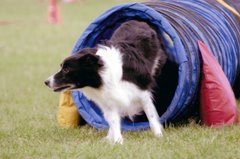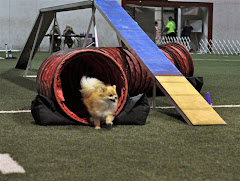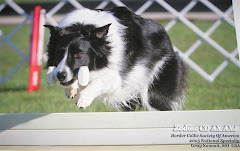In the grand scheme of things, there are certainly worse things than a diagnosis of Addison's Disease.
The period of time between your dog getting sick and being diagnosed can be very scary, indeed. The symptoms of Addison's Disease (AD) can mirror that of so many other things -- things like cancer, tumors, liver failure, etc. -- all of which, in the long run, are far worse than AD.
Because this is a disease that your dog will have for the rest of its life, it is very important for the owner of an A-dog to become very educated about this disease and its treatment. The good news is that modern medicine has made this a very treatable disease! Once properly medicated, an A-dog can go on to live a completely normal life. My dog, Luke, has earned five Championship titles in agility since being diagnosed in 2009!
The key to living well with AD is to work with your veterinarian to find the proper dose of medication for your dog. There are two widely accepted forms of medications for dogs with AD. One is a daily dose of pills called Florinef. Florinef contains a steroid component and thus no other medication is required. Some dogs do very well on Florinef, although the consensus among the A-dog community is that most dogs end up needing higher and higher doses as they continue with treatment. Sometimes this leads to the dog receiving too much of the steroid component, which can cause problems. Those dogs ultimately tend to end up switching to alternate treatments.
My vet and I decided that the better option for my dog, Luke, would be Percorten-V, which is a shot that I give him every four weeks. In addition, I must give him a small amount of Prednisone daily to make up for the cortisol that his body is no longer producing. Luke gets 1.25mg per day, which is pretty miniscule. In times of stress it is often helpful for the owner to up the amount of steroids given and this will vary by dog. I have never come across a situation where my dog needs additional Prednisone. Agility trials are happy stress for him, but he does fine on his usual dose. Staying in a boarding kennel might be one situation where additional Prednisone is recommended.
Owners of dogs with AD can expect to become good friends with their veterinarians, as it will require frequent visits until the magic dose is found. Once diagnosed and given the first dose of medication, generally you will return for weekly blood tests to make sure things are progressing as they should. In these blood draws, we are checking the dog's electrolyte levels, always aiming for a happy range of Sodium (NA) and Potassium (K) levels. These levels vary depending on your vet's machine, but we shoot for a ratio between 27-40.
When the blood tests reveal that the K is starting to rise and the NA is starting to drop, it's time for another shot of Percorten (or to give higher doses of Florinef). Ideally you are hoping for this to happen within a range of 4-5 weeks. Often times dogs are grossly overmedicated (per label directions) with Percorten and I've heard of some owners going three to four months before their dog is ready for another shot. The negative aspect of this is that these overmedicated dogs often do not start to feel like themselves again until their levels start to balance out again, so the more we can avoid overmedicating, the better! Finding the perfect balance of dose & duration is something that can take a bit of time, and until you settle on that sweet spot you will be making regular trips in for blood work.
Once you get there, though, life is pretty easy! You graduate to doing blood tests quarterly, bi-yearly and then yearly at your dog's annual physical. I write the date of my dog's next shot on my fridge and give him Prednisone every morning with his other supplements. Aside from that, I don't do anything differently for Luke than my other dogs. I do watch him closely, though, and I don't hesitate to take him into the vet for blood work if he seems to be feeling punky. While most dogs settle on a single dose for Percorten and are fine there for life, sometimes there are dogs who will need adjustments later on.
There is a fantastic support group on Yahoo groups that I cannot recommend enough: http://pets.groups.yahoo.com/group/AddisonDogs_ Most of what I know, I learned from that great group of people. It is moderated by owners of other A-dogs who have years of experience in treating this disease. There are even a couple of respected veterinarians who make appearances (most notably, Dr. Nancy Kay, author of "Speaking for Spot" and also Dr. Julia Bates, known for being one of the first veterinarians to do a study on starting with lower doses of Percorten). Often times owners of newly diagnosed A-dogs can feel tremendously overwhelmed. Having a support network of other A-dog owners is invaluable and also helps those who unfortunately are dealing with veterinarians who are not well educated about the disease or its treatment.
It costs me approximately $40/month to treat Luke for Addison's Disease. It is a paltry sum for the quality time I get to continue to spend with my dog! :o)
Karissa













.jpg)
.jpg)



.jpg)


